#USS Wyoming
Explore tagged Tumblr posts
Text
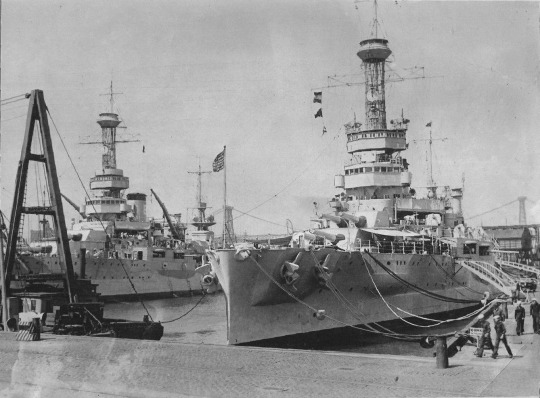
"WHICH WAR DOG WILL SURVIVE?
Both USS WYOMING (BB-32) (left) and USS ARKANSAS (BB-33) (right) must be scrapped under the terms of the London naval treaty. But one will escape the scrap heap as a training ship. They wait in the Brooklyn Navy Yard, New York, while officers decide."
Photographed on May 14, 1930.
source, source
#USS WYOMING (BB-32)#USS WYOMING#USS ARKANSAS (BB-33)#USS ARKANSAS#Wyoming Class#Dreadnought#Battleship#Warship#Ship#United States Navy#U.S. Navy#US Navy#USN#Navy#New York Navy Yard#Brooklyn Navy Yard#Brooklyn#New York City#New York#East Coast#May#1930#interwar period#my post
41 notes
·
View notes
Text
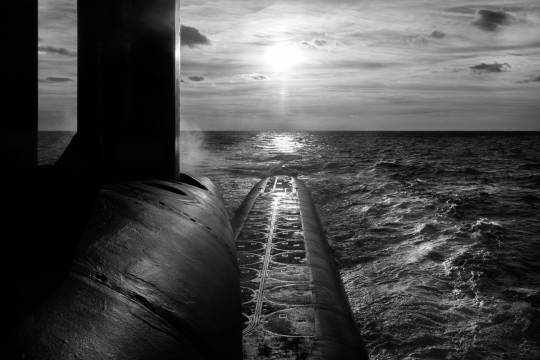
The nuclear submarine USS Wyoming at an undisclosed location in the Atlantic. Along the length of the four-story ship run an array of missile tubes, their circular exit doors ominously visible on the hull.
Photograph by Philip Montgomery.
3 notes
·
View notes
Text

The Ohio-class ballistic missile submarine USS Wyoming (SSBN-742) approaches Naval Submarine Base King Bay, Ga, (Jan. 9, 2009).
38 notes
·
View notes
Text

USS Wyoming building up steam to leave New York, 1915.
158 notes
·
View notes
Text
OK… read this prompt by @call-me-casual and decided to give John a break for a bit before the USS Lexington story continued.
Hope you enjoy.
••••••••
Scott groaned as he came to his senses.
He wasn't sure where he was or what was going on...
"Wasn't I on a mission?" he thought groggily.
As he became more conscious, he realized that it wasn't the sound of birds and gentle ocean waves at home.
It was the roar of Thunderbird One.
That woke him up... but at the same time... he felt like he couldn't move.
There was a bitter licorice aftertaste to his mouth, his head felt like cotton.
It was only the faint memory of this occurring before in Thunderbird Four that he realized what happened.
He had been drugged... by the ship using its Omicron protocol.
Scott opened his eyes, head still bowed though.
A light was flashing on the console… in Morse code his still fuzzy mind recognized.
"TB1 - taken - over - by - AI - STOP - Put - on - helmet - STOP - Will - explain - in - helmet."
Well, if that wasn't an alert, Scott mused.
He then heard a voice, not unlike John's permeate his ears.
"Alert - enemy is conscious. Omicron protocol activated."
That wasn’t calm assurance, and something said “do it this time.”
Scott didn't hesitate at that internal order - especially as a hiss shortly followed.
He held his breath and grabbed the emergency air mask underneath his seat.
Putting it on, he quickly unbuckled and went for his helmet.
Thunderbird One didn't like that, and tried to shake him.
Scott crashed into multiple walls, including the one with an intake that looked like a lemon squeezer. "Definitely a squeeze," he mused internally as he picked up his helmet.
Putting it on, he turned on the radio to a frequency even EOS didn't know how to reach - herself at least. "Thunderbird One to anyone." He said in a not quite calm tone as he worked to get back to his chair.
Sitting in it, and buckling tight, he looked at the controls. "That can't be right," he said looking at the coordinates.
He last remembered being in Crook County, Wyoming finishing up aiding a trapped hiker rescue at the top of a fiery Devil's Tower.
Readouts said he was flying over Almaty, Kazakhstan.
A tenor voice pestered his voice. "Scott... Scott do you read?" said John.
The eldest narrowed his eyes. "How do I know you're John?" he said.
There was a sigh - probably with rolled eyes, as the middle brother spoke. "Tuesday Alan and Gordon decided to send me up a burger that was nothing but pickles in my from home gift... along with two dozen of Grandma's Sweet Onion cookies - that I said were good because she managed to keep them soft," he said.
Scott paused, then nodded. "You're ... you,” he said relieved, “A moment ago you tried to render me unconscious.”
A uncommonly heard cat like growl from John filtered his ears. "I didn't - it was One," he said and continued after Scott's puzzled grunt. "You were on your way home from the rescue when EOS reported you lost consciousness. I did a scan and found Omicron had been administered."
"Wouldn't that mean she goes back to GDF or home?" he said, remembering the protocol. "I just passed Almaty."
"For the fourth time,”John said and heard Scott's grunt of confusion. “You were unconscious for about an hour.”
“An hour?”
“The AI kept using the protocol if you started coming around. It just didn’t catch it now - thankfully.”
Scott groaned, knowing he’d have a headache eventually. “WHY is it doing that though?”
The space brother then coughed, which Scott knew he'd not like hearing this. "The AI Brains created for One thinks you are the hiker who kicked her... snuck aboard TB1, and sedated - maybe harmed or worse - ‘Scott’ after a fight.”
"That explains Omicron," said Scott, who did a double take. "Wait... it was the reverse - I sedated him after he tried punching me. He went with the authorities…”
“… I know. The facial ID glitched and - as the hiker has a similar look to you, it got confused.”
There was a shudder by One as two thumps sounded from the front. "What was that Five?”
John didn’t miss the - fair enough - panic in the tone, "Thunderbirds Three and Two just lassoed One. We're trying to get her to slow down before she runs out of fuel,” he said.
"Right..." Scott tried to play it cool. but was indeed panicked.
Based on fuel load, One could circle the globe 6 times, so they had two rotations to stop her before...
Then a baritone voice, similar to Virgil's dwarfed the conversation in the helmet.
“Please do not be alarmed. You have 30 minutes of air left in Scott's air tank before you will crash and die," it said. "It would be easier on you if you were unconscious for it. A mercy given you hurt Scott.”
The real Virgil's voice however filtered in Scott's helmet. "Hey, I'd *never* tell someone to deal with that skunky stuff," he said, much to Scott's mild amusement.
The engineering brother continued. "John and EOS are trying to get the AI to listen to us, and Brains is working on a failsafe code to fix the face scanner,” he said. “Alan and I have securely lassoed One just in case she tries to crash herself."
"As if I didn't need anything else," muttered Scott, facepalming over the mask. "What can I do?"
"Sit as calm as you can - I know... I know ... too difficult, but try," said Virgil. "If you can, talk to it. It seems to like to be our voices."
"FAB," said Scott and leaned back. "So... why are you doing this?"
"I must protect Scott," “Virgil” said.
"By rendering Scott unconscious?" said the pilot. When it chirped in confusion, he continued. "Check my face again - I'm Scott."
"No. You are the hiker who harmed him," the voice, now sounding like Alan said.
"No - again I’m Scott..." he said, deciding the next thing he did would be worth the ironic lecture from John.
“I'm going to take off my helmet and hold my breath... Please use the scanner again - twice if necessary - to see that it's me,” he said, ignoring the others’ protests.
The man took a deep breath and pulled his helmet off. The AI scanned him, and based on how much his lungs were begging him to take a breath of anesthetic gas and oxygen, twice.
Fortunately, the AI recognized it was Scott.
"You're Scott," it said in Virgil's voice as Scott quickly put the helmet back on, gasping for air. “Where is the person who sedated you?"
"The hiker who kicked you in spite is with the authorities - not here," said Scott said, trying to placate the AI.
"But it still tried to kill you and me... it hit sensitive components," "John" responded. "It's since escaped and had two ships try to bind me. I will destroy them if they do not let go."
Scott winced as the AI spun One, which would affect Two more than Three.
When it stopped, Scott contacted the other two 'Birds. Alan said he was all right as his cockpit was designed to take spins, while Virgil admitted he was a little dizzy but he and TB2 were unharmed.
Scott then looked around his ship, hoping it wasn't going to be a tomb. "Listen, they’re not with the creep. These two are trying to bind you because they want to protect me too," he said.
"Protect you?" said AI, now choosing to be in Gordon's voice. "I protect you."
"Yes, like you do... and I do you every rescue," he said, then took a deep breath. "But those two ships? They're Thunderbirds Two and Three. They're trying to slow us down because you're doing loops around earth. If you keep doing it, you'll run out of fuel and crash."
The AI hummed a bit in John's vocals and commented. "But - won't people such as the hiker go and hurt you again?" it said.
Scott pursed his lips, thinking how to respond. He didn't want to give the honest answer, as he was afraid she'd just crash One into a city, causing countless deaths in injuries.
But he couldn't lie either.
So he chose the straightforward route. "One - I can't say they will or won't. You know we're in a rescue business. There's always the chance there will be a distraught person or criminal who will attack me for many reasons," he said.
“And me?”
“Yes, you too because you’re a very special ship,” he said, then sighed. "The point is - I know that when I go on rescues, when my brothers go on rescues, you - Two, Three, Four and Five - do your absolute best to protect us."
He just read the coordinates for Almaty again... he hoped this last part would hit home.
"Just - please - Brains is working on a way to help you better discern an annoyed rescuee versus someone who really wants to harm or kill us, such as the Hood," he said, and heard Gordon's ironic grumble in response as it pondered.
Scott continued pleading. "Just please protect me, Alan, Virgil and countless others by slowing down before we all get hurt?"
There was a pause - making Scott feel as though he was probably going to have to decide if he just accepted being drugged again so he felt nothing - including guilt - when One elected to crash.
Instead... he felt the ship slow down, and a chirp from the AI.
"Understood. I am letting Two and Three assist me back to the Island," said "John's" voice as the real John and other brothers cheered in relief in Scott's helmet. "Omicron protocol disengaged."
Scott however smiled as he felt the craft turn around. "Thank you One. Can you tell me when the gas will disperse," he said.
"In about 20 minutes, but you will be home before then," said "John." "Recommend you wear the helmet until you arrive, and any family who may come near the ship to wear gas masks.
Scott nodded and leaned back, knowing that his brothers would safely fly his 'Bird - and him - home safely.
Besides - he needed a bit of a snooze.
Then the AI chirped. "Um... Scott, one question."
"Name it."
"Can I change my voice to something other than your brothers?" it said. "I do not like any of them."
The pilot chuckled. "You can try any voice you want - for as long as you want," he said, yawning slightly from the last vestiges of the gas. "As long as you remember my voice and double check to make sure I'm all right first before enacting protocols again."
"FAB - rest easy - my colleagues and I will get you home safely - as always."
#melmac78 observation#thunderbirds are go#gordon tracy#virgil tracy#john tracy#scott tracy#alan tracy#TAG fanfic prompt#thunderbirds are to fanfiction#call-me-casual
27 notes
·
View notes
Text

Sergeant Major Gilbert “Hashmark” Johnson (October 30, 1905 – August 5, 1972) was one of the first African Americans to enlist in the Marine Corps and one of the first African American drill instructors in the Marine Corps. He was known as “Hashmark” because he had more service stripes than rank stripes. He retired in 1959 after 32 years of service in the Armed forces, including 17 years as a Marine.
He was born to a farming family in rural Mount Hebron, Alabama. He attended Stillman College, aspiring to become a minister, but he left college the following year to join the Army.
He enlisted in the 25th Infantry Regiment in 1923, serving two three-year tours. He was discharged as a corporal. He decided to join the Navy. In 1933, he enlisted in the Naval Reserve and was accepted into the Stewards Branch, the only job available to African Americans at that time, he served in the Navy for nearly 10 years. In May 1941, he entered the regular Navy. He served aboard the USS Wyoming at the time of the bombing of Pearl Harbor.
In 1941, President Franklin D. Roosevelt issued Executive Order 8802, requiring the Marine Corps to accept African Americans and forbidding discrimination by military contractors. He requested a transfer from the Navy to the Marine Corps. He and other African Americans served in segregated units.
In 1943, he was among the first African American men to be trained as Marine drill instructors. In May 1943 at Montford Point, he replaced the drill instructor. As a member of the 52d Defense Battalion, on Guamin WWII, he asked that African American Marines be assigned to combat patrols, from which they had been exempt. Once approved, he led 25 combat patrols.
Edgar Huff, the only other African American Sergeant Major besides him to serve during WWII, was his brother-in-law. They were married to twin sisters. #africanhistory365 #africanexcellence
13 notes
·
View notes
Text

A-10 Warthogs Escort Ballistic Missile Submarine USS Wyoming
For the second time in the last few months, A-10C jets escorted an Ohio-class nuclear submarine and also took part in a life fire exercise.
Stefano D'Urso
A-10 submarine
An A-10C Thunderbolt II maneuvers over the ballistic missile submarine USS Wyoming. (Image credit: U.S. Navy)
A formation of A-10C Thunderbolt II close-air support aircraft were employed once again to escort an Ohio-class ballistic missile submarine, the USS Wyoming (SSBN 742). The images, shared on social media by Submarine Group Ten, depict Wyoming and its escorts navigating in an undisclosed location in the United States, with six A-10Cs flying overhead.
The aircraft, assigned to Moody Air Force Base, escorted the submarine and were also involved in a live fire exercise with their GAU-8 30 mm gun and 70 mm rockets. The U.S. Coast Guard Maritime Force Protection Unit Kings Bay, USNS Black Powder (T-AGSE-1), and USNS Westwind (T-AGSE-2) also participated in the escort of the submarine.
The rare sighting is not unprecedented, as earlier this year the USS Nebraska was also escorted by a quartet of A-10 Warthogs while navigating the Strait of San Juan de Fuca. In that occasion, however, the A-10s did not take part in any life fire activity and flew without carrying external ordnance.
“Joint operations, such as this one which involved the Air Force, Coast Guard, and Navy, ensure the U.S. military is ready to meet its security commitments at home and abroad,” mentioned the statements on both occasions. The services did not further elaborate on the extend of the joint operations.
The A-10C and the maritime domain
While no other details were released, it appears the Warthogs practiced overwatch of the extremely high-value strategic asset during one of the most vulnerable phases of its navigation. The live fire exercise might have also been used to simulate the defense of the USS Wyoming from surface threats.
A-10s have been used to target swarms of boats and to strike small naval vessels in previous training exercises, demonstrating the attention that these types of asymmetric threats attracted following recent real word events, such the attacks in the Red Sea or the Black Sea.
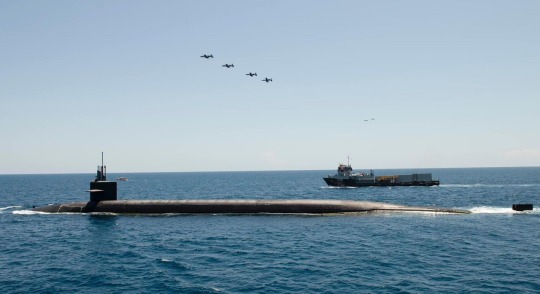
Four A-10Cs fly over the USS Wyoming, while two other jets can be seen in the background. (Image credit: U.S. Navy)
The A-10, which was born as a pure Close Air Support and anti-tank platform, has never been employed to large extent in the maritime domain, seeing only limited use. One of the most notable episodes was in 2011 during Operation Unified Protector, when an A-10 and a P-3C Orion engaged together a patrol boat and several small attack craft in the port of Misrata, Libya.
Since the last two couple of years, the Warthog was part of multiple Maritime Surface Warfare exercises and conducted unit defense training. One of the exercises saw, in Sept. 2023, two A-10s engage simulated surface threats in the Gulf of Oman with the Arleigh Burke-class guided-missile destroyer USS Stethem.
The A-10’s maneuverability at low airspeeds and altitude, highly accurate weapons-delivery capabilities, and extended loiter time are all key attributes that make it highly effective at providing aerial support to American and coalition forces on land and at sea, mentioned the U.S. Air Force after one of these exercises last year.
Asymmetric threats to maritime assets
The events in the Black Sea and Red Sea highlighted once again how asymmetric threats cannot be underestimated. In the past, the U.S. Navy had experience countering small fast attack crafts, especially in the Persian Gulf where Iran regularly harassed U.S. ships in the area.
More recently, Ukraine and the Houthis demonstrated the effectiveness and the danger posed by Unmanned Surface Vehicles (USVs), used in kamikaze attacks against larger ships. The small, unmanned boats, filled with explosives, can exploit their limited dimensions and high maneuverability to avoid detection and interception, with devastating effects on their targets.

An A-10C Thunderbolt II engages a simulated target with its GAU-8 30 mm gun. (Image credit: U.S. Navy)
Highly defended targets could be overwhelmed by coordinated swarms of USVs, challenging the traditional naval strategies. The presence of multiple, fast approaching and maneuvering targets against a limited number of weapon systems on a naval asset could confuse the defenses, which would be forced to prioritize targets as to maximize the hit probability and avoid wasting precious ammo.
And here is where overhead protection from and asset like the A-10C could come in handy, as it provides to naval commanders a number of options both for surveillance and kinetic effects.
About Stefano D'Urso
@TheAviationist.com
Stefano D'Urso is a freelance journalist and contributor to TheAviationist based in Lecce, Italy. A graduate in Industral Engineering he's also studying to achieve a Master Degree in Aerospace Engineering. Electronic Warfare, Loitering Munitions and OSINT techniques applied to the world of military operations and current conflicts are among his areas of expertise.
14 notes
·
View notes
Text

Title: USS Wyoming (BB-32)
Description: Passing through the Galliard Cut, Panama Canal, 26 July 1919. View looks south. Collection of Colonel J. Willcox, USMC(Retired). U.S. Naval History and Heritage Command Photograph.
Catalog #: NH 73825
9 notes
·
View notes
Text

USS Wyoming (AG-17) underway in the Atlantic Ocean on 30 April 1945
32 notes
·
View notes
Text

USS ARKANSAS (BB-33), USS WYOMING (BB-32) and another battleship at anchor in San Diego Bay, California.
Photographed in August 1919.
Online Archives of California: 7622 CD M0189
#USS Arkansas (BB-33)#USS Arkansas#USS Wyoming (BB-32)#USS Wyoming#Wyoming Class#Dreadnought#Battleship#Warship#Ship#United States Navy#U.S. Navy#US Navy#USN#Navy#San Diego#California#West Coast#August#1919#interwar period#my post
15 notes
·
View notes
Text
BTS - The Pilot and his Girl

I was talking to some mutuals, who also write darker themes, about what we google and I realised readers probably don’t know about the amount of ridiculous research we sometimes put into tiny details in stories. And the ridiculous details we google!
The Pilot and his Girl covered a lot of darker topics, PTSD, drug abuse and withdrawal, handling grief and trauma among other things. But it also included details about guns, military insignia and markers, Boston weather, Wyoming weather, geographical markers and local flora and fauna. And I did A LOT of googling to cover all the details.
More below the cut if you’re curious, but my personal favourite was when Google gave me a warning banner about drug addiction, assuring me there was help to be had and here’s a list of local resources. I was only trying to figure out what withdrawals Frankie would go through as he came down off his addiction…
So I did a fair bit of googling before the outbreak even happened, including the fish Denny catches in the lake on the fourth of July. It’s a fish that lives pretty much all over North America so I didn’t need to specify the state. Had I known that The Pilot would grow into a 300´000+ word fic I would’ve outlined where they lived and how they travelled in more detail in the beginning.
In the fic they live in Arlington, but that’s not mentioned until after the outbreak and although they are somewhere in the south, where, is never specified. Arlington became their hometown simply because it’s the third most common place name in the US, Franklin being the most common (hence the name of the first QZ…). And Washington Park, where Frankie thinks he kills a man in the early hours of the outbreak, is the second most common place name.
In one of the earlier chapters Frankie’s PTSD flares up in a bad way after his girlfriend is shot. I, thankfully, have no experience with PTSD so I read up and found good resources online from both treatment centres and stories from people who had suffered from PTSD, especially military veterans. So I put all of that into my writing and received the ultimate comment when one of my readers asked if I worked with PTSD patients because they had experience of it and they thought I had written Frankie’s episode so well. That made me so happy because capturing what he goes through well was important to me because it’s a major theme in the fic.
A small detail readers probably missed are the signs Pope and Frankie leave for each other as they travel from the cabin in Lucía’s town. I don’t know why, but I was adamant about them being correct and spent way too much time looking up what signs special ops soldiers would use. So go ahead, look them up, I can guarantee that they’re correct!
Oh and their guns? Yeah, it’s not a coincidence that Frankie picks up a Glock when he enters the looted gun shop. It’s one of their preferred handguns.
After Pope, Benny, Frankie and his girl leave the Arlington QZ and head to New York they have to cross the Appalachian mountains. And the trail they’re on exists, as does the bridge they’re on when they’re attacked and capture Morrow, their guide. The shop they get to as they go through Hoboken, Hoboken Beer & Soda Outlet, is a real place, as is of course, Sinatra Park. And as they travel further north, from New York, up to Boston, you can follow the path they take, first the ship from Orchard Park up to Nonquitt Bay and up past the USS Massachusetts, and through the Boston suburbs. I love geography and I had to make it real, at least for myself!
Boston winters are harsh, I already knew that, so I had to figure out the timeline of spring potentially arriving and work out when Frankie and his girl could leave after Pope dies. Frankie’s addiction and withdrawals took a lot of googling, as did figuring out what drugs/medicines would still be actually usable. There’s a mention of antibiotics being good for years after their expiration date and this is also true, stored correctly they don’t lose their effect.
And once they left, I googled my way across the midwest and marvelled at how FLAT and STRAIGHT those states are! My mind was blown and I spent way too much time using Google Street view to just click my way across Nebraska. I used a lot of those images to describe the landscape that they travelled through, both by car and on foot, and how it changes as you get closer to the Rockies. And of course I googled the climate for that valley that Jackson is in and how a hydroelectric plant works but please forgive me, that is NOT how you repair one. Major artistic licence was taken to make that scene readable….
The one MAJOR deviation from facts I had to make was petrol. But as the same deviation is made in both the game and tv-show I let it slide. In reality, they wouldn’t be able to drive the cars with petrol that had been sitting other cars out in the open. Petrol breaks down very fast, even after a month in a car it’s lost a lot of its quality. After a year it starts clogging the car. Twenty years? No way…. The thing is, in the apocalypse, bicycles are what you need!
But despite all that googling I did, someone did point out (in the nicest possible way) one mistake that I made. In the early days in Jackson baby Jack is fed honey because I figured it would be the one sweetener they would potentially have on hand. But apparently, honey shouldn’t be given to children under the age of one… But I have no kids so the thought didn’t even occur to me that he shouldn’t be eating it. But now I know and I don’t think I’ll ever forget because it will always make me think of baby Jack and Frankie!
If you’ve read this far, I hope you’ve enjoyed this little “behind the scenes” bit and if you have any questions, just ask. Funnily enough, most writers love talking about their works. ❤❤❤
#the pilot and his girl#frankie morales#frankie morales x reader#pedro pascal character fanfiction#frankie morales x you#the last of us#the last of us fanfiction
27 notes
·
View notes
Text
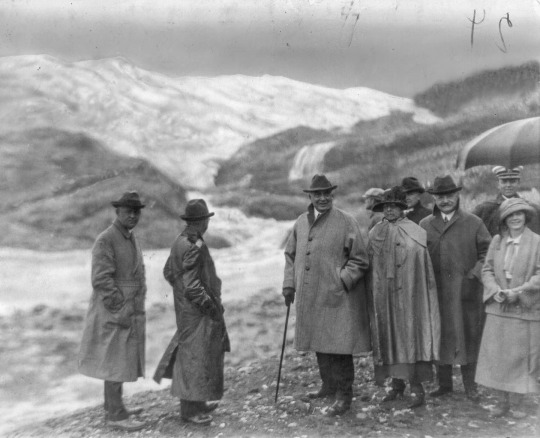
Exactly 100 years ago, President Warren Gamaliel Harding escaped the sweltering summer weather and increasingly dark political climate of Washington, D.C. to embark upon a lengthy cross-country trip through parts of the American West still relatively unaccustomed to frequent visits by the nation’s Chief Executive. Billed as a “Voyage of Understanding”, Harding’s trip was seen as a prelude to his potential campaign for re-election the following year, and an opportunity to put some literal and figurative distance between the President and the rumors of rampant corruption swirling around some of Harding’s friends and closest aides from Ohio, as well as several Cabinet members — rumors eventually proven to be true, resulting in indictments, convictions, prison sentences, and even suicides. As President Harding prepared for his Western tour, he could feel the heat as the scandals plaguing his Administration began to reach a boiling point. Speaking privately to the famous journalist and editor William Allen White, Harding said of the Presidency, “My God, this is a hell of a job! I have no trouble with my enemies…But my damn friends, they’re the ones that keep me walking the floor nights.”
Harding’s planned 15,000-mile Voyage of Understanding began on June 20, 1923. Traveling aboard the private Pullman railroad car Superb, the 57-year-old President left Washington, D.C. accompanied by First Lady Florence Harding, Speaker of the House of Representatives Frederick H. Gillett, new Interior Secretary Hubert Work, and a large retinue of aides, friends and their families, doctors, Secret Service agents, and members of the press. Work had become Secretary of the Interior a few months earlier when the previous Secretary, Albert B. Fall, became the “fall guy” for the Teapot Dome scandal. For his role in the scandal, Fall was later convicted of accepting bribes — the first former Cabinet member in American history to serve time in prison for crimes committed while in office. At later points along the journey, Harding’s party was also joined by Secretary of Agriculture Henry C. Wallace (father of future Vice President Henry A. Wallace) and Secretary of Commerce (and future President) Herbert Hoover.

The last week of June 1923 was spent traveling through the Mountain West — Colorado, Wyoming, Utah, Idaho, Montana, and Yellowstone National Park. The beginning of July saw the Presidential party in the Northwest and celebrating Independence Day in Portland, Oregon before boarding the USS Henderson in Tacoma, Washington on July 5, 1923 to sail to Alaska. One of the expected highlights of the Voyage of Understanding was the northernmost leg of the trip, as Harding became the first incumbent President of the United States to visit Alaska and Canada. The Territory of Alaska had been purchased for the United States by Secretary of State William Seward in 1867 when Warren G. Harding was two years old, and at the time of Harding’s visit, Alaska was still 35 years from being admitted to the Union as the 49th state. But the President spent nearly the entire month of July traveling through the state, mixing public appearances with private recreation and sightseeing. On July 15, 1923, Harding hammered a golden spike in Nenana, Alaska to officially complete the Alaska Railroad. And ten days later, the President crossed into Canada, fishing on the Campbell River in British Columbia on July 25th and then making an official visit the following day in Vancouver, where he was greeted by one of the largest crowds of his voyage — estimated at over 40,000 people — and where he also squeezed in a round of golf at the exclusive Shaughnessy Golf Club.
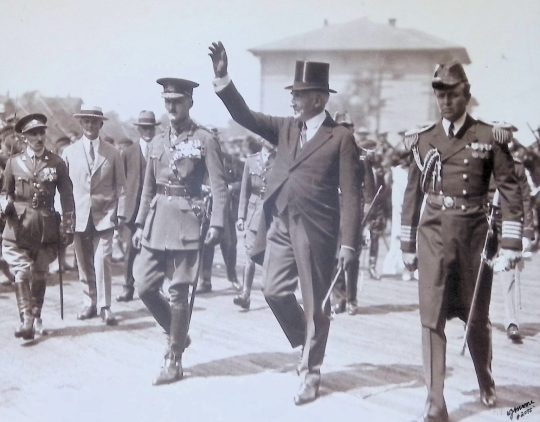
The President returned to American soil on July 27th, arriving in Seattle and making several speeches in a busy six-hour period — first to Camp Fire Girls at Volunteer Park, then to nearly 30,000 Boy Scouts at Woodland Park, and finishing the day addressing over 30,000 people at what is now Husky Stadium at the University of Washington where he predicted statehood for Alaska, where he had spent most of the month. After making a brief appearance that evening at the Seattle Press Club, Harding boarded his train that night to travel to Portland, Oregon.
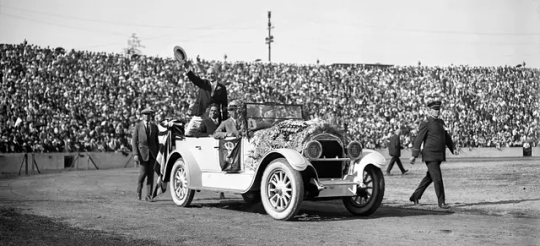
But something was not right. The President seemed to be exhausted, perhaps from the grueling trip through geography much wilder than Harding’s native Ohio or swampy Washington, D.C. Despite his exciting journey through Alaska and the energetic welcome provided by the Canadian people, Harding was clearly wiped out by the time he reached British Columbia. The President did head to the country club while in Vancouver, but he was so tired that after six holes of golf his foursome skipped directly to the eighteenth hole, seemingly completing the round without tipping off the press that Harding couldn’t play the entire course.
From the White House, nine days before embarking upon his Voyage of Understanding, Harding wrote a quick note to Solicitor General James M. Beck who had wished the President a safe journey on his upcoming trip. Thanking Beck, Harding wrote, “I shall try to remember not to overdo (it) in crossing the continent.” And, on June 14, 1923, six days before leaving, President Harding wrote a short letter to a young girl from Hartford, Connecticut named Vivian Little, who had recently sent the President a four-leaf clover as a good luck charm. “Thank you so much for the four-leaf clover which you were so good as to press and send to me,” the President wrote. “I hope it will bring me good luck and that it will bring you still more of the same.”
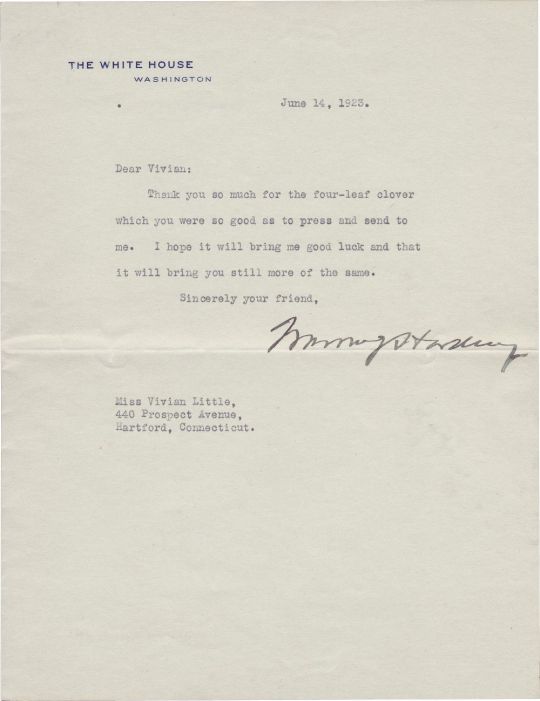
However, any luck that President Warren G. Harding still had seemed to be running out. Ill and exhausted after leaving Vancouver, Harding tried to rest aboard the USS Henderson as it sailed to Seattle in the early morning hours of July 27. At some point around 3 AM, Harding and the other passengers aboard the Henderson were jolted awake as the ship crashed into the USS Zeilin, an American destroyer accompanying the Presidential party while they traveled through the foggy Puget Sound. This was not the first mishap of the Voyage of Understanding. While traveling through Colorado early in the trip, three people from the President’s party had been killed in a car accident. And now, after a few weeks in Alaska where Harding was able to at least temporarily forget about his Administration’s many troubles, the President was not only sick and tired but two of his Navy’s ships had just smashed into each other almost as soon as he had returned to the continental United States. While the USS Zeilin was badly damaged in the collision, the USS Henderson was not and there were apparently no major injuries on either vessel. But when the President’s valet, Major Arthur Brooks, came to Harding’s stateroom aboard the Henderson to inform him that the captain was calling for all hands on deck, he found the depressed President lying on his bed with his face buried in his hands. “I hope the boat sinks,” President Harding quietly muttered.
It was just hours later that Harding made his whirlwind tour through Seattle, putting on a brave face at his public appearances, but clearly not feeling well. While he was never considered a brilliant orator like Abraham Lincoln, Benjamin Harrison, or his immediate predecessor, Woodrow Wilson, Harding was a strong speaker and excellent communicator who had a unique ability to connect with audiences, but he was obviously — and unusually — halting and confused while speaking in Seattle on July 27th. As he boarded his train at Seattle’s King Street Station that night, Harding was examined by his doctor and by Interior Secretary Hubert Work, who had once been a physician, and they decided to cancel the next several days of planned activities. Instead of stopping in Portland and then visiting Yosemite National Park, the Presidential party was ordered to proceed directly to San Francisco where Harding could rest before giving a speech on the radio planned for July 31st which was expected to be heard by over 5 million people.
Despite the four-leaf clover that had been sent to him by Vivian Little before his Voyage of Understanding, Warren Gamaliel Harding’s luck seemed to be running out. And, as his train sped through Oregon en route to San Francisco’s Palace Hotel on July 28, 1923, President Harding was also running out of time.
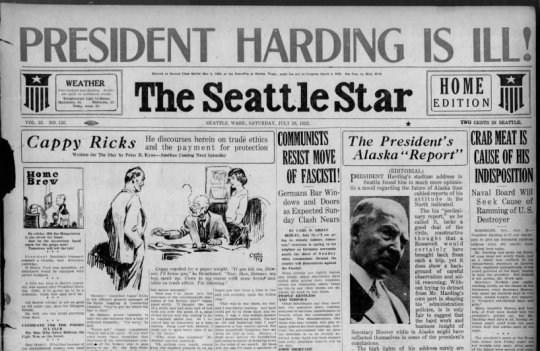
#History#Presidents#Warren G. Harding#President Harding#Death of Warren G. Harding#100 Years Ago#100th Anniversary#Centennial#Presidential History#Voyage of Understanding#Politics#Political History#Harding Administration#Presidential Deaths#Teapot Dome#Presidential Scandals#Presidential Corruption#Political Scandals#Political Corruption
50 notes
·
View notes
Text

USS Wyoming (SSBN-742) commissioning ceremony at the Electric Boat Division of General Dynamics Corp., Groton, CT., 13 July 1996. Note in the background the Archerfish (SSN-678) heading to the Mediterranean Sea for a six month deployment.
32 notes
·
View notes
Text
I've seen this happen in my family. This is my brother. Born in 1937.

And here's his doppelgänger at the launch of the USS Wyoming battleship in 1912.


Love this so much!!
8K notes
·
View notes
Text
Events 1.15 (before 1950)
69 – Otho seizes power in Rome, proclaiming himself Emperor of Rome, beginning a reign of only three months. 1541 – King Francis I of France gives Jean-François Roberval a commission to settle the province of New France (Canada) and provide for the spread of the "Holy Catholic faith". 1559 – Elizabeth I is crowned Queen of England and Ireland in Westminster Abbey, London. 1582 – Truce of Yam-Zapolsky: Russia cedes Livonia to the Polish–Lithuanian Commonwealth. 1759 – The British Museum opens to the public. 1777 – American Revolutionary War: New Connecticut (present-day Vermont) declares its independence. 1782 – Superintendent of Finance Robert Morris addresses the U.S. Congress to recommend establishment of a national mint and decimal coinage. 1815 – War of 1812: American frigate USS President, commanded by Commodore Stephen Decatur, is captured by a squadron of four British frigates. 1818 – A paper by David Brewster is read to the Royal Society, belatedly announcing his discovery of what we now call the biaxial class of doubly-refracting crystals. On the same day, Augustin-Jean Fresnel signs a "supplement" (submitted four days later) on reflection of polarized light. 1822 – Greek War of Independence: Demetrios Ypsilantis is elected president of the legislative assembly. 1865 – American Civil War: Fort Fisher in North Carolina falls to the Union, thus cutting off the last major seaport of the Confederacy. 1867 – Forty people die when ice covering the boating lake at Regent's Park, London, collapses. 1870 – A political cartoon for the first time symbolizes the Democratic Party with a donkey ("A Live Jackass Kicking a Dead Lion" by Thomas Nast for Harper's Weekly). 1876 – The first newspaper in Afrikaans, Die Afrikaanse Patriot, is published in Paarl. 1889 – The Coca-Cola Company, then known as the Pemberton Medicine Company, is incorporated in Atlanta. 1892 – James Naismith publishes the rules of basketball. 1908 – The Alpha Kappa Alpha sorority becomes the first Greek-letter organization founded and established by African American college women. 1910 – Construction ends on the Buffalo Bill Dam in Wyoming, United States, which was the highest dam in the world at the time, at 99 m (325 ft). 1911 – Palestinian Arabic-language Falastin newspaper founded. 1919 – Rosa Luxemburg and Karl Liebknecht, two of the most prominent communists in Germany, are clubbed and then shot to death by members of the Freikorps at the end of the Spartacist uprising. 1919 – Great Molasses Flood: A wave of molasses released from an exploding storage tank sweeps through Boston, Massachusetts, killing 21 and injuring 150. 1934 – The 8.0 Mw Nepal–Bihar earthquake strikes Nepal and Bihar with a maximum Mercalli intensity of XI (Extreme), killing an estimated 6,000–10,700 people. 1936 – The first building to be completely covered in glass, built for the Owens-Illinois Glass Company, is completed in Toledo, Ohio. 1937 – Spanish Civil War: Nationalists and Republicans both withdraw after suffering heavy losses, ending the Second Battle of the Corunna Road. 1943 – World War II: The Soviet counter-offensive at Voronezh begins. 1943 – The Pentagon is dedicated in Arlington County, Virginia. 1947 – The Black Dahlia murder: The dismembered corpse of Elizabeth Short was found in Los Angeles. 1949 – Chinese Civil War: The Communist forces take over Tianjin from the Nationalist government.
0 notes
